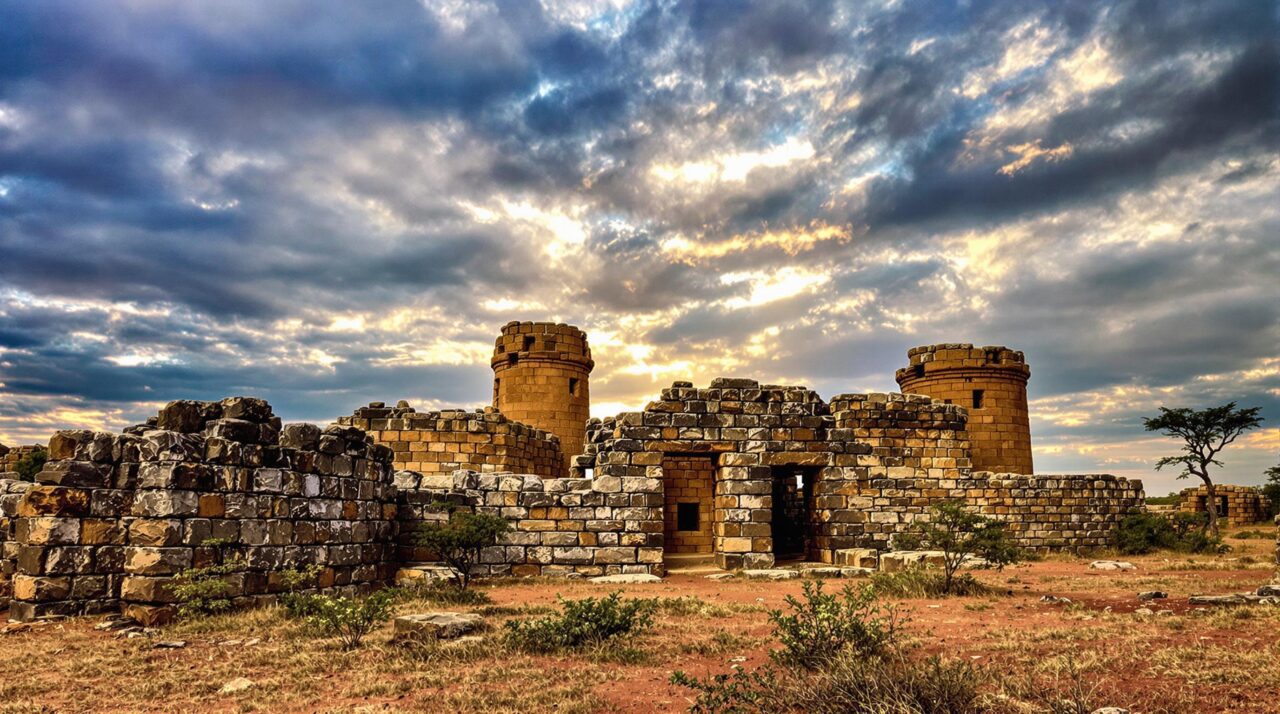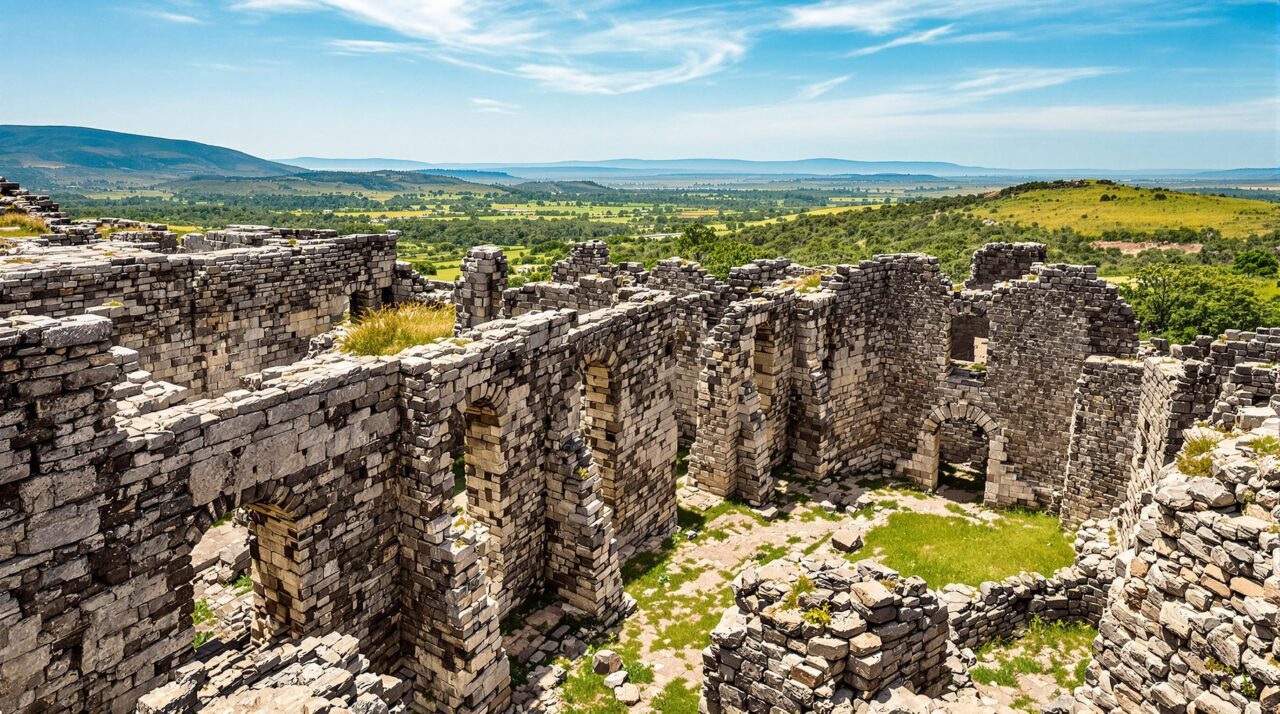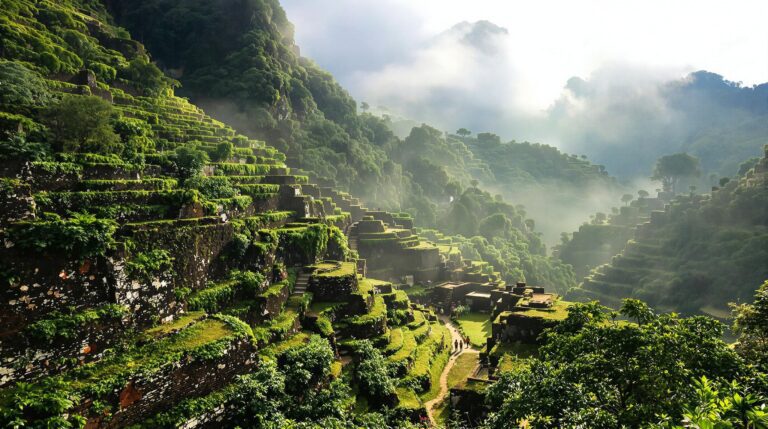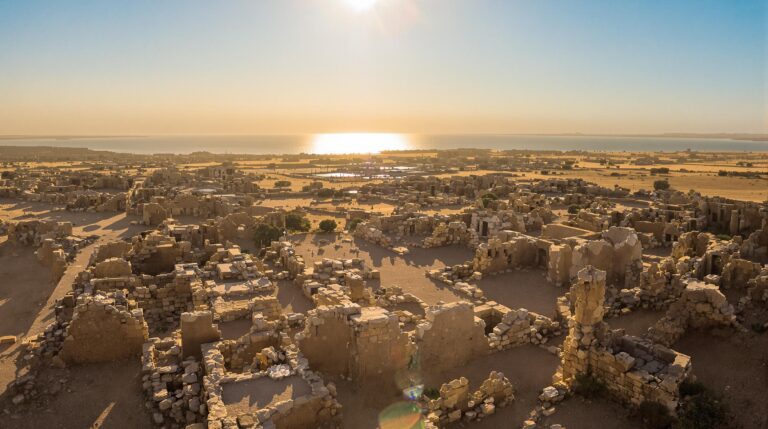Great Zimbabwe: The Stone City’s Secrets in Africa

Great Zimbabwe emerges from the mists of history, its stone walls whispering secrets of a sophisticated civilization.
Once a center of trade and culture, the site challenges preconceived notions about Africa’s past.
The intricacy of its architecture evokes both awe and curiosity. Yet, the true story of its rise and fall remains shrouded in mystery.
What drove this remarkable society? What can its remnants teach us about the interconnectedness of ancient worlds?
TL;DR
Hide- Great Zimbabwe showcases advanced stone masonry techniques and urban planning, reflecting a sophisticated civilization in southern Africa.
- The site served as a major trade nexus, facilitating the exchange of gold, ivory, and cultural practices across regions.
- Environmental challenges, such as soil erosion and climate change, threaten the preservation of this UNESCO World Heritage site.
- Innovative archaeological technologies, like 3D mapping, enhance understanding of Great Zimbabwe's historical significance and architectural marvels.
- Great Zimbabwe symbolizes national identity for Zimbabweans, fostering cultural pride and educational initiatives that celebrate its rich heritage.
Historical Origins and Rediscovery of Great Zimbabwe

In the heart of southern Africa, the remnants of Great Zimbabwe whisper tales of a prehistoric kingdom, where stone walls rose majestically against the horizon, signifying a complex society that flourished long before colonial encounters.
Rediscovered in the early 20th century, these ruins sparked a fervent wave of excavations, revealing the intricate artistry and cultural richness of a civilization that defied the narratives of its time.
As archaeologists unearthed artifacts and structures, they began to piece together the enigmatic story of a land once lively with trade and innovation, challenging preconceived notions of African history.
Emergence of a Prehistoric Kingdom
In the heart of southern Africa, the rise of Great Zimbabwe marked the emergence of a formidable civilization, its legacy woven through the fabric of oral traditions and early chronicles.
Scholars and historians have sought to unearth the layers of this prehistoric kingdom, revealing a tapestry of power, trade, and culture that flourished long before its rediscovery.
As the stones of its majestic ruins whisper tales of a lively past, the enigma of Great Zimbabwe continues to captivate the imagination of those who seek to understand its origins.
The Rise of a Powerful African Civilization
As the sun dipped below the horizon, casting golden hues across the rugged landscapes of southeastern Africa, the nascent civilization of Great Zimbabwe began to rise from the shadows of prehistory.
Flourishing through rich trade routes and skilled craftsmanship, this powerful kingdom emerged, showcasing towering stone structures and lively culture, a tribute to human ingenuity and the relentless pursuit of identity amidst the vast African expanse.
Oral Traditions and Early Records
The legacy of Great Zimbabwe is intricately woven into the fabric of oral traditions and early records, offering a glimpse into the kingdom’s historical origins and the narratives that shaped its identity.
These accounts illuminate the past, revealing:
- The significance of trade routes
- Cultural exchanges with distant lands
- Social hierarchies within the kingdom
- The spiritual connection to the land
Each story echoes the resilience of its people.
20th Century Rediscovery and Excavations
In the late 19th century, the rediscovery of Great Zimbabwe revealed a long-hidden narrative of an ancient civilization, enchanting explorers and scholars alike.
As excavations unearthed intricate stone structures and artifacts, a profound realization dawned: this was not merely the relic of a lost kingdom, but a demonstration of the vibrant mosaic of African history and culture.
The revelations ignited debates that would reshape perceptions of Africa’s past, challenging colonial narratives and highlighting the continent’s historical significance.
Initial Finds and Archaeological Revelations
Although largely forgotten for centuries, Great Zimbabwe emerged from the shadows of history in the late 19th century, enchanting the imagination of explorers and archaeologists alike.
Initial finds revealed:
- Elaborate stone structures
- Intricate carvings and artifacts
- Evidence of trade networks
- Cultural significance of the site
These discoveries sparked a profound curiosity, challenging preconceived notions of Africa’s historical narrative and its architectural prowess.
Impact on Modern African History
As explorers unearthed the remnants of Great Zimbabwe in the late 19th century, a profound transformation began to reshape the narrative of African history.
This monumental discovery shattered colonial misconceptions, illuminating the advanced socio-economic structures of pre-colonial Africa.
The ruins stood as a symbol of resilience, inspiring a newfound pride and identity among Africans, while challenging the historical lens through which their past was viewed.
Architectural Mastery and Urban Planning
Great Zimbabwe stands as a tribute to the brilliance of its builders, who employed innovative stone masonry techniques that have withstood the test of time.
The city’s complex layout, with its carefully designed public spaces, reveals a sophisticated understanding of urban planning that catered to both functionality and community engagement.
As one navigates the ruins, the echoes of a lively society resonate through the meticulously crafted walls, inviting contemplation of an architectural legacy that continues to inspire.
Innovative Stone Masonry Techniques
In the heart of Great Zimbabwe, the mastery of stone masonry emerges as a manifestation of ingenuity and resourcefulness, utilizing local materials in ways that harmonized with the landscape.
These structures, with their intricately interlocking stones, not only showcased architectural brilliance but also withstood the ravages of time, whispering stories of a civilization’s aspirations.
The urban planning of this ancient site revealed a sophisticated understanding of space, where every wall and curve reflected both function and artistry in a remarkable balance.
Use of Local Materials and Advanced Engineering
Crafted from locally sourced granite, the impressive structures of Great Zimbabwe stand as a tribute to the ingenuity of its builders, who mastered the art of stone masonry without the use of mortar.
This architectural triumph showcases:
- Precision in stone cutting
- Innovative interlocking techniques
- Masterful urban planning
- Sustainable use of local resources
Together, these elements reflect a profound understanding of engineering and design, transcending time.
Structures that Defied Time
While the passage of centuries often erodes the legacies of human achievement, the enduring structures of Great Zimbabwe stand as a tribute to architectural mastery and innovative stone masonry techniques.
Skillfully crafted from granite, their interlocking stones defy both time and nature. This ancient city showcases sophisticated urban planning, where each edifice tells a story of resilience, ingenuity, and an unyielding spirit of creativity.
Complex City Layout and Public Spaces
At Great Zimbabwe, the intricate interplay of defensive walls and imposing towers creates a formidable silhouette against the vast African landscape, hinting at the sophisticated urban planning that once thrived within.
Ceremonial areas, meticulously designed and strategically located, served as focal points for community gatherings, reflecting a society rich in culture and social organization.
Evidence of organized urban life emerges not just from the stone structures, but from the very layout of the city itself, which speaks volumes about the ingenuity and aspirations of its builders.
Defensive Walls, Towers, and Ceremonial Areas
Great Zimbabwe’s architectural landscape is defined by its imposing defensive walls, intricately designed towers, and sacred ceremonial areas, which collectively showcase an extraordinary mastery of urban planning and engineering.
These features reflect both functionality and symbolism, weaving a narrative of power and spirituality:
- Robust stone structures
- Elevated vantage points
- Sacred gathering spaces
- Impressive craftsmanship
Each element contributes to the site’s enigmatic allure and cultural significance.
Evidence of Organized Urban Life
The intricate layout of Great Zimbabwe reveals a sophisticated urban tapestry, where each pathway and public space is a tribute to the civilization’s architectural prowess and social organization.
Stone structures, seamlessly integrated with nature, form communal hubs that fostered interaction. The strategic design showcases an understanding of urban planning, reflecting a lively society that thrived in harmony, ingenuity, and shared purpose amid the rugged landscape.
Socioeconomic and Cultural Influence
Great Zimbabwe emerged as a lively nexus of trade and power, its stone walls echoing the bustling exchanges of gold, ivory, and ideas that shaped the region.
Beneath its towering structures lay a diverse mosaic of spiritual and cultural significance, where ancestral beliefs and traditions wove together the fabric of daily life.
The legacy of this ancient civilization continues to resonate, inviting contemplation of its profound influence on both past and present societies.
Role as a Hub of Trade and Power
Great Zimbabwe emerged as a lively nexus of trade, weaving intricate networks that spanned the continent, linking distant lands through the exchange of gold, ivory, and exotic goods.
Its towering stone walls not only symbolized political might but also served as a demonstration of its economic significance, shaping the cultural landscape of the region.
As merchants and travelers converged within its borders, Great Zimbabwe pulsated with the rhythms of commerce and innovation, leaving an indelible mark on the socio-economic fabric of Africa.
Extensive Trade Networks Across Africa
At the heart of southern Africa, a tapestry of trade routes wove through the landscape, connecting diverse cultures and economies in a lively exchange of goods and ideas.
Great Zimbabwe emerged as a focal point, facilitating:
- Gold and ivory exports
- Cultural exchanges through art and language
- Agricultural innovations
- The spread of religious beliefs
These connections fostered a rich socio-economic landscape, shaping regional identities.
Political and Economic Significance in the Region
How did a single site become a beacon of political and economic power in southern Africa?
Great Zimbabwe emerged as a formidable hub, its towering stone walls echoing with the whispers of trade and governance.
The city’s strategic location fostered lively commerce, connecting distant lands and cultures, while its wealth cultivated influence, making it a symbol of resilience and authority in an ever-evolving landscape.
Spiritual and Cultural Legacy
The spiritual and cultural legacy of Great Zimbabwe resonates through its intricate religious practices and the symbolic artifacts that whisper tales of the past.
These remnants not only shaped the identity of local communities but also wove themselves into the colorful tapestry of folklore that endures to this day.
Consequently, the echoes of this ancient civilization continue to influence the socioeconomic landscape, guiding generations in their understanding of heritage and belonging.
Religious Practices and Symbolic Artifacts
Enveloped in the intricate fabric of Great Zimbabwe’s history, religious practices and symbolic artifacts reveal a profound interplay between spirituality and cultural identity.
The sacred landscapes and monuments echo ancestral reverence, while artifacts embody communal beliefs.
- Stone carvings representing deities
- Ritualistic pottery adorned with spiritual motifs
- Altars serving as sites for offerings
- Sacred animal imagery reflecting societal values
Influence on Local Folklore and Identity
As the sun sets over the ancient ruins of Great Zimbabwe, shadows dance across the landscape, weaving tales of a rich cultural legacy that continues to resonate within local folklore.
Stories of ancestral spirits and mythical creatures imbue the region’s identity, fostering a sense of belonging. This deep-rooted connection to the past nourishes the community’s cultural essence, shaping aspirations and preserving traditions for future generations.
Debates and Theories Surrounding Great Zimbabwe
Controversies swirl like desert winds around the origins and purpose of Great Zimbabwe, a monumental site that has captured the imagination of historians and archaeologists alike.
Myths and misconceptions weave a complex tapestry, obscuring the truth of a civilization that flourished amidst the striking stone ruins.
As scholars grapple with these debates, the echoes of its past resonate, challenging perceptions and inviting deeper inquiry into the heart of this enigmatic landmark.
Controversies Over Origins and Purpose
The majestic ruins of Great Zimbabwe, with their intricately carved stone walls and sprawling expanse, serve as a battleground for contrasting narratives about their origins.
Scholars grapple with the tension between celebrating indigenous achievements and acknowledging external influences, each argument steeped in the shadows of colonial reinterpretations.
As modern perspectives emerge, the purpose of this ancient civilization remains cloaked in mystery, inviting further exploration into its profound legacy.
Indigenous Achievements Versus External Influences
Debate surrounds the majestic ruins of Great Zimbabwe, where the echoes of a once-thriving civilization resonate through time.
Scholars grapple with the interplay of indigenous innovation and external influences, questioning the origins and purpose of this remarkable site.
- Architectural mastery in stonework
- Trade connections across the Indian Ocean
- Cultural synthesis with neighboring societies
- Resistance against colonial narratives
Reinterpretations in Colonial and Modern Contexts
How has the perception of Great Zimbabwe shifted over the centuries, reflecting broader historical narratives?
Initially dismissed as a colonial fantasy, recent scholarship embraces its indigenous origins and complex social structures.
This reevaluation challenges Eurocentric views, asserting that Great Zimbabwe was a thriving epicenter of trade and culture—an enduring symbol of African ingenuity and resilience, reclaiming its rightful place in the tapestry of human history.
Myths and Misconceptions
The towering stone ruins of Great Zimbabwe stand as a tribute to a complex history often shrouded in myth and misrepresentation.
Historical biases have long clouded perceptions of this ancient civilization, while modern academic perspectives continue to unravel the layers of truth buried beneath centuries of speculation.
As ongoing research breathes new life into forgotten narratives, the quest to illuminate the realities of Great Zimbabwe becomes ever more essential.
Misrepresentations and Historical Biases
Although Great Zimbabwe stands as a monumental tribute to African ingenuity, its history has often been clouded by misrepresentations and biases that skew understanding of its true significance.
- Eurocentric narratives often overshadow African contributions.
- Misinterpretations have led to unfounded theories of foreign influence.
- Archaeological findings are frequently dismissed.
- Local oral histories are undervalued, silencing indigenous voices.
Modern Academic Perspectives and Ongoing Research
As scholarly inquiry into Great Zimbabwe evolves, a tapestry of modern academic perspectives emerges, revealing a landscape rich in debate and reinterpretation.
Researchers challenge long-held myths, exploring the city’s architectural prowess and its role in regional trade.
Ongoing excavations and interdisciplinary approaches illuminate its cultural significance, inviting a rethinking of narratives that have historically marginalized African contributions to civilization and heritage.
Preservation Efforts and Modern Discoveries
In the shadow of the ancient stone walls of Great Zimbabwe, modern archaeologists wield cutting-edge technology to uncover secrets long buried beneath the earth.
Yet, the grandeur of this historical marvel is threatened by the relentless forces of time and human activity, presenting a complex tapestry of conservation challenges.
As scholars grapple with preserving its legacy, each discovery adds a new layer to the narrative of a civilization that once flourished in the heart of Africa.
Advances in Archaeological Technology
In the shadow of Great Zimbabwe‘s ancient stone walls, modern archaeology embraces cutting-edge technology to disclose the site’s enduring mysteries.
Remote sensing and 3D mapping breathe new life into forgotten landscapes, while digital reconstruction illuminates the architectural marvels of a bygone era.
As new excavations reveal tantalizing evidence, the narrative of this once-thriving civilization continues to evolve, challenging perceptions and igniting curiosity.
Remote Sensing, 3D Mapping, and Digital Reconstruction
Advancements in archaeological technology have revolutionized the understanding of Great Zimbabwe, revealing its hidden complexities through a blend of remote sensing, 3D mapping, and digital reconstruction.
These innovative techniques illuminate the site’s grandeur and intricacies, allowing researchers to:
- Uncover unseen structures
- Analyze spatial relationships
- Visualize historical landscapes
- Preserve cultural heritage
Such methods empower a deeper appreciation for Africa’s rich historical tapestry.
New Excavations and Emerging Evidence
How does the unearthing of new artifacts reshape the narrative surrounding Great Zimbabwe?
Fresh discoveries, unearthed through advanced techniques, reveal intricate trade links and societal structures once obscured by time.
Fragments of pottery and tools, glistening under the sun, whisper tales of a lively civilization.
Each find adds depth to a rich history, inviting a reexamination of identity and cultural legacy in the heart of Africa.
Challenges in Conservation
As the ancient stones of Great Zimbabwe stand resilient against the winds of time, they face a growing array of threats from both nature and human activity.
Environmental degradation, coupled with the pressures of tourism and urban encroachment, challenges the delicate balance of preservation efforts.
In response, collaborative projects emerge, weaving together innovative strategies and local knowledge to safeguard this monumental heritage for future generations.
Environmental and Human Impacts on the Site
Great Zimbabwe, a tribute to an ancient civilization’s ingenuity, faces a multitude of environmental and human challenges that threaten its very existence.
These factors jeopardize its legacy:
- Deforestation due to agricultural expansion
- Soil erosion from unregulated tourism
- Vandalism and theft of artifacts
- Climate change impacting local ecosystems
Such issues demand urgent attention to preserve this monumental symbol of Africa’s rich history.
Collaborative Projects for Sustainable Preservation
While the challenges facing Great Zimbabwe loom large, a beacon of hope emerges through collaborative projects aimed at sustainable preservation.
Engaging local communities, historians, and conservationists, these initiatives weave a tapestry of shared responsibility.
Utilizing innovative techniques and traditional wisdom, they breathe life into stone structures, ensuring that the whispers of the past resonate for future generations, fostering a profound sense of heritage.
Global Legacy and Contemporary Impact
Great Zimbabwe stands as a beacon of cultural rebirth, igniting a profound sense of national identity and pride among Zimbabweans.
Its majestic stone walls not only tell tales of an ancient civilization but also shape contemporary narratives in international archaeology and tourism, drawing scholars and travelers alike to its storied past.
Through this lens, the site bridges history and modernity, fostering connections that resonate well beyond its rugged landscapes.
Reviving National Identity and Pride
Great Zimbabwe stands as a towering monument to the ingenuity and resilience of African heritage, its ancient stone walls whispering tales of a lively civilization.
In contemporary discourse, educational and cultural initiatives are utilizing this legacy to ignite a renewed sense of national identity and pride among Zimbabweans.
As the echoes of history resonate in modern hearts, the site becomes a powerful touchstone for a collective narrative, fostering unity and celebration of a rich cultural past.
Great Zimbabwe as a Symbol of African Heritage
Heritage embodies a powerful connection to the past, and in the case of Great Zimbabwe, it stands as a monumental tribute to the ingenuity and resilience of African civilizations.
This iconic site symbolizes:
- The architectural brilliance of ancient societies
- A source of national pride and identity
- The enduring spirit of African culture
- A beacon for future generations to reclaim their narrative.
Educational and Cultural Initiatives
The legacy of Great Zimbabwe reverberates through contemporary educational and cultural initiatives, breathing new life into a shared national identity.
Schools weave its history into curricula, while artists draw inspiration from its grandeur, creating lively expressions of pride.
Cultural festivals celebrate heritage, fostering unity and resilience.
These endeavors not only honor the past but also ignite a collective spirit, empowering future generations to embrace their roots.
Influence on International Archaeology and Tourism
Great Zimbabwe stands as a beacon, drawing scholars and adventurers alike to its ancient stone walls, where whispers of a lively past echo through time.
The site not only captivates the imagination but also serves as a wellspring of inspiration for contemporary architecture and artistic expression, reflecting its enduring legacy.
As researchers sift through its mysteries, the allure of Great Zimbabwe transforms into a diverse mosaic of cultural exchange, forever altering the landscape of international archaeology and tourism.
Attraction for Researchers and Travelers
Echoes of an ancient civilization resonate through the stone ruins of Zimbabwe, drawing researchers and travelers alike to the enigmatic site of Great Zimbabwe.
This archaeological marvel captivates the curious with its mysteries and grandeur, fostering a deep appreciation for cultural heritage.
- A nexus for archaeological exploration
- A symbol of pre-colonial African history
- Inspiration for sustainable tourism
- A bridge for cultural exchange
Inspirations for Modern Architecture and Art
Ancient stone walls of Great Zimbabwe not only tell tales of a once-thriving civilization but also serve as a wellspring of inspiration for modern architecture and art.
Their intricate designs echo through contemporary structures, while artists draw from their rich textures and forms.
This legacy, infused with both historical depth and aesthetic allure, continues to captivate global creators, fostering a dialogue between past and present.
Wrapping Up
In the grand tapestry of history, Great Zimbabwe emerges as a colossal jewel, shimmering with secrets and stories that defy the sands of time.
Its stone walls, whispering tales of a civilization that danced with trade winds and wove cultural tapestries, beckon explorers and dreamers alike.
As preservation efforts breathe new life into this ancient wonder, Great Zimbabwe stands monumental, not merely as a relic but as an eternal beacon, illuminating Africa’s lively past and inspiring the world’s imagination.





